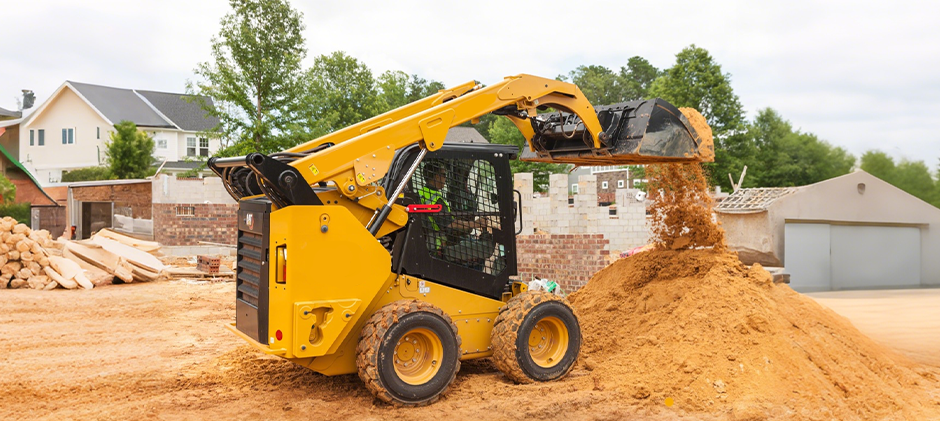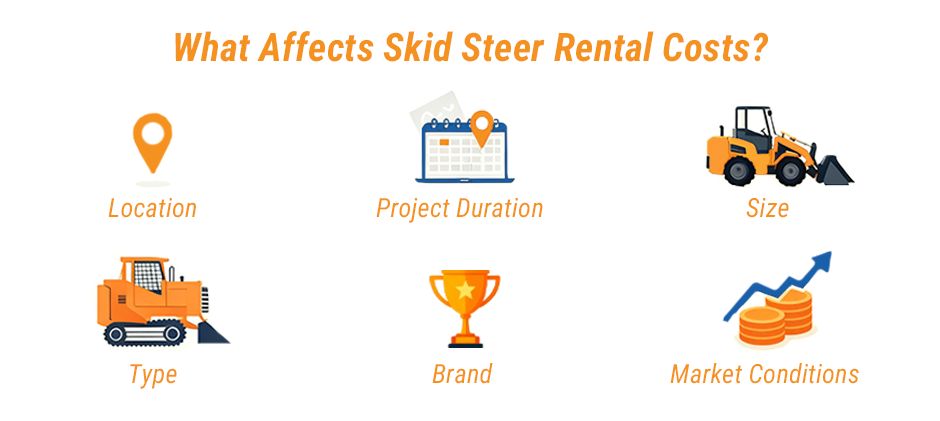How much does it cost to rent a skid steer? If you are hesitating between buying or renting, knowing the full cost of a skid steer rental can help you decide. This guide will cover some of the rental rates of a typical skid steer, as well as factors affecting the cost. We also take into account some additional costs so that you can budget for the next project.

How Much Does a Skid Steer Cost to Rent?
Here are the estimated daily, weekly, and monthly costs for skid steer rental:
Cost to Rent a Skid Steer for a Day
Daily rental prices for a skid steer range from $200 to $500, but prices vary depending on the model and size. For example, a Kubota SCL1000 stand-on model rents for about $260 per day, while a SVL95 tracked model costs around $440 per day. For those on a budget, Bobcat offers a more affordable option—the S570 model can be rented for as low as $134 per day, making it a cost-effective choice.
Cost to Rent a Skid Steer for a Week and a Month
Weekly rental for a skid steer ranges from $600 to $1,900, while monthly rates range from $1,500 to $5,000. Here’s an overview of prices for some of the most popular models.
| Model | Weekly Rental Cost | Monthly Rental Cost |
|---|---|---|
| Bobcat Skid Steer Loaders | Starting at $726 | Starting at $2,178 |
| Kubota SCL1000 Stand-On Skid Steer | $780 | $1,950 |
| Kubota SSV65 | $900 | $2,250 |
| John Deere 314G | $1,000 | $2,950 |
| Kubota SVL95 | $1,320 | $3,500 |
| Kubota SVL97 | $1,320 | $3,500 |
| John Deere 318G | $1,495 | $3,690 |
| John Deere 317G | $1,500 | $3,950 |
| John Deere 331G | $1,890 | $5,400 |
Wheeled vs. Tracked Skid Steer Rental Costs
Compared to the wheeled skid steer, the tracked skid steer rental price range using tracks would be higher.
| Average Daily Rates | Average Weekly Rates | Average Monthly Rates | |
|---|---|---|---|
| Wheel Skid Steer | $200-$450 | $600-$1,000 | $1,200-$3,500 |
| Track Skid Steer | $300-$500 | $700-$1,500 | $2,000-$4,000 |
What Affects Skid Steer Rental Costs?
Knowing what factors affect the rental will help you make the right choice when choosing products and suppliers. Skid steer rental prices vary widely across the country, depending on the local market and the competitiveness of the region. Consider the following factors to obtain an accurate cost estimate:

Location
The location of your workplace can also affect the cost. For example, in areas with more new construction, rental costs may be higher because of the limited supply of available skid steers. To get an accurate estimate, enter your exact location while browsing rental options or requesting a quote.
Project Duration
The longer you rent the equipment, the cheaper the daily price. This is the common rule for renting construction equipment. Knowing your project’s timeline before renting will help you cut costs and save money when you need it.
Size
Usually, Skid steers have three sizes: small-frame, medium-frame, and large-frame. Small models are relatively affordable, while larger models often cost more. Large skid steers have more power and higher lifting capacity. Of course, fuel consumption will increase as well. If your project requires handling of heavy loads, choosing a large loader is necessary.
Type
There are two main types of skid steers: tracked and wheeled. There is a big price difference between the two. Track loaders are often more expensive to purchase, move, and maintain.
Brand
Most brands have similar loaders, but some rentals are more expensive, possibly due to brand reputation, unique configurations, or the preferences of the leasing company. A flexible brand choice can usually have a more affordable price. To find the best solution, compare the pros and cons of different brands.
Market Conditions
Rental prices are influenced by supply and demand. During peak construction seasons, like spring and summer, demand is high and rates often rise. In winter, the snow-removal attachment costs are also higher. In areas with more construction projects, it is more expensive.
Other Costs to Consider
There are other costs of renting a skid steer. These charges do not always count towards the basic rental price. Costs such as fuel, labor, and your time add up to reflect the total cost of renting.
Fuel Costs
You will need to pay for the fuel consumption of the loader. Include fuel costs in your project budget based on expected usage time. Heavy equipment needs to be regularly filled with hydraulic and other fluids to work. You can talk with your rental provider.
Operator Training
If you and your team don’t have much experience, it’s necessary to set aside a budget for operator training. Training helps workers handle the skid steer to work more efficiently. It also teaches safety practices to protect themselves and others on the job site.
Attachments
Based on different attachments, the skid steer has multiple functions. Besides the standard bucket, you can choose pallet forks, snow plows, augers, etc., according to project needs. These extra attachments are often available for an additional fee and sometimes even rented separately.
Transportation Costs
The farther your workplace is from your supplier, the more you will have to pay for pickup and delivery. Choosing a nearby supplier can help save money. If you’ll move the equipment between several job sites for a long period, make sure you have a trailer that fits the machine and the insurance to transport it safely and legally.
Insurance
Most rental companies will ask you to carry contractor’s skid steer insurance. You generally have two options:
Provide Your Own Insurance: If you are a contractor, you can provide a Certificate of Insurance (COI) from your business policy. This certificate must list the rental company as an “additional insured” and “loss payee.”
Purchase a Damage Waiver: If you don’t have your own insurance, you will be required to purchase a Loss Damage Waiver (LDW) or Rental Protection Plan (RPP) from the rental company. This typically adds 10-15% to your total rental cost and covers damages to the machine, though it often comes with a deductible.
How to Save on Skid Steer Rental Costs
While many costs are fixed, there are several ways to reduce your overall spending:
- Plan Accurately: Book the exact time you need. If your project timeline is flexible, gather your work to fit into a full week or month. Compared to several short-term rentals, it can lower your actual daily rate.
- Choose the Right Size: A smaller skid steer is more affordable and fuel-efficient. Conversely, renting a machine that’s too small will reduce efficiency, making you rent it for longer.
- Book in Advance: Booking ahead gives you a wider selection and lower rates.
Conclusion
Knowing the true rental cost of loaders helps to choose the right machine within budget. Rented equipment is used in many projects, and failures sometimes occur. Contacting a rental company is an option, but it is usually expensive and time-consuming. The easier way is to replace parts yourself. Having a reliable source of parts is key. FridayParts offers a wide range of loader parts, compatible with many brands. Repair quickly and ensure the progress of your project.
